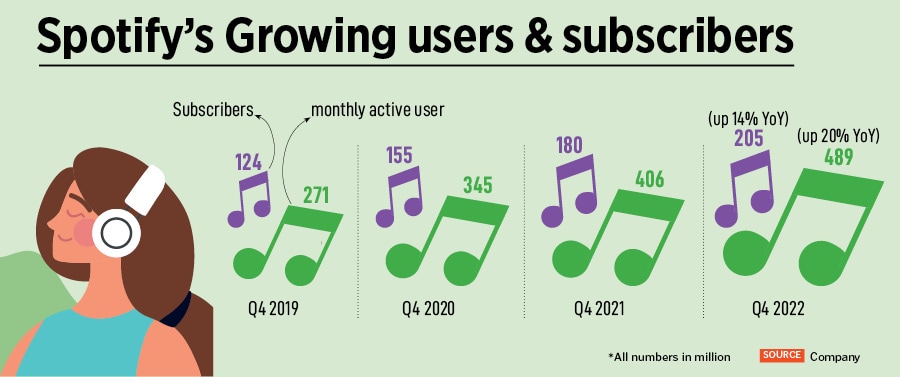
Why Spotify is hitting high notes in India
Spotify has grown in India on the back of an artiste-centric approach and adapting its subscription models. Can it now earn meaningful revenue in a price-conscious market by betting on localisation and podcasts?
 From left: Dhruvank Vaidya, head of podcasts, Spotify India; Amarjit Singh Batra, general manager, SAMEA (South Asia, Middle East, Africa) and managing director, Spotify India; Rahul Balyan, head of music, Spotify India and Gustav Gyllenhammar, vice president, Markets and Subscriber Growth at Spotify
Image: Neha mithbawkar for Forbes India
From left: Dhruvank Vaidya, head of podcasts, Spotify India; Amarjit Singh Batra, general manager, SAMEA (South Asia, Middle East, Africa) and managing director, Spotify India; Rahul Balyan, head of music, Spotify India and Gustav Gyllenhammar, vice president, Markets and Subscriber Growth at Spotify
Image: Neha mithbawkar for Forbes India
If you are on any social media platform, scrolling through Instagram reels or YouTube Shorts, chances are you have heard the song ‘Maan meri jaan’. This viral sensation by Arpan Kumar Chandel, aka King, became the #1 song in India’s Top 50 charts, making it the first-ever for non-film Indian music and #25 on Spotify’s Global Top 50.
Though he is one of the most popular artistes on Swedish audio streaming platform Spotify, he joined the platform as a listener in 2017. “It was one of the few platforms where I could explore and get inspired by the work of new artistes,” recalls Chandel, who continues to spend most of his time on the platform as a listener. The rapper became a creator on Spotify in 2020 by releasing his first album Carnival. One of his songs, ‘Tu aake dekhle’ was out on other platforms as well, but Chandel says, “I think once I got on Spotify, that song really blew up and went viral”.
Chandel started at 1.2 million monthly listeners in April 2022 and after the release of ‘Maan meri jaan’ in October 2022, his monthly listeners shot up to 14.5 million. “For an artiste, Spotify is very easy to use and gives insights into what kind of songs people want to listen to,” he adds.
This creator-centric approach has been a blessing for independent Indian artistes, by giving them a platform to showcase their work. Spotify helps them get discovered, eventually get larger projects, democratise the profession, and make it a viable career option.
In the last four years, since Spotify launched operations in India, it has seen phenomenal growth, not just in music, but also podcasts. “When we launched, there were five to six existing players in the market,” says Gustav Gyllenhammar, vice president, Markets and Subscriber Growth at Spotify. “But the performance here has surpassed even our best case-scenario, in terms of growth, especially given the size and complexity of the market; it was not an easy task.”




 “From a pure user growth point of view, it is one of the fastest growing markets—making it one of our top five strategic markets globally. We have tripled our audience in India over the last 24 months. If we continue doing things right, revenue will definitely follow,” says Gyllenhammar.
“From a pure user growth point of view, it is one of the fastest growing markets—making it one of our top five strategic markets globally. We have tripled our audience in India over the last 24 months. If we continue doing things right, revenue will definitely follow,” says Gyllenhammar. 




